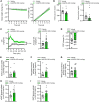GIPR agonism mediates weight-independent insulin sensitization by tirzepatide in obese mice
- PMID: 34003802
- PMCID: PMC8203452
- DOI: 10.1172/JCI146353
GIPR agonism mediates weight-independent insulin sensitization by tirzepatide in obese mice
Abstract
Tirzepatide (LY3298176), a dual GIP and GLP-1 receptor (GLP-1R) agonist, delivered superior glycemic control and weight loss compared with GLP-1R agonism in patients with type 2 diabetes. However, the mechanism by which tirzepatide improves efficacy and how GIP receptor (GIPR) agonism contributes is not fully understood. Here, we show that tirzepatide is an effective insulin sensitizer, improving insulin sensitivity in obese mice to a greater extent than GLP-1R agonism. To determine whether GIPR agonism contributes, we compared the effect of tirzepatide in obese WT and Glp-1r-null mice. In the absence of GLP-1R-induced weight loss, tirzepatide improved insulin sensitivity by enhancing glucose disposal in white adipose tissue (WAT). In support of this, a long-acting GIPR agonist (LAGIPRA) was found to enhance insulin sensitivity by augmenting glucose disposal in WAT. Interestingly, the effect of tirzepatide and LAGIPRA on insulin sensitivity was associated with reduced branched-chain amino acids (BCAAs) and ketoacids in the circulation. Insulin sensitization was associated with upregulation of genes associated with the catabolism of glucose, lipid, and BCAAs in brown adipose tissue. Together, our studies show that tirzepatide improved insulin sensitivity in a weight-dependent and -independent manner. These results highlight how GIPR agonism contributes to the therapeutic profile of dual-receptor agonism, offering mechanistic insights into the clinical efficacy of tirzepatide.
Keywords: Diabetes; Metabolism; Therapeutics.
Conflict of interest statement
Figures







References
MeSH terms
Substances
LinkOut - more resources
Full Text Sources
Other Literature Sources
Medical

